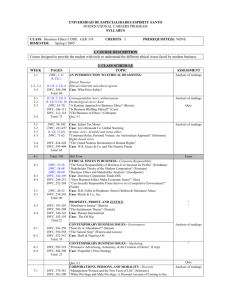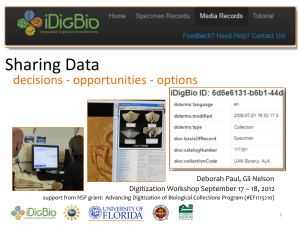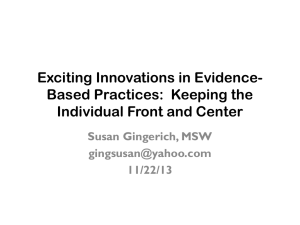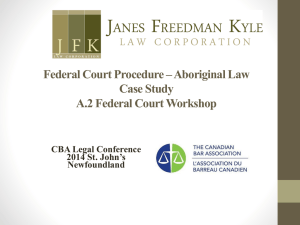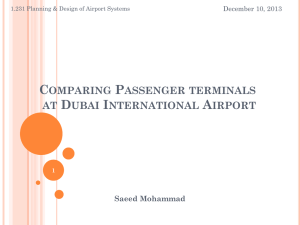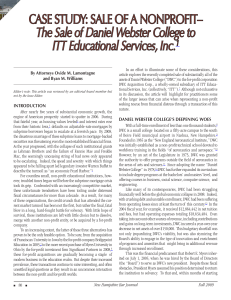Peter Spalding Power Point Presentation
advertisement
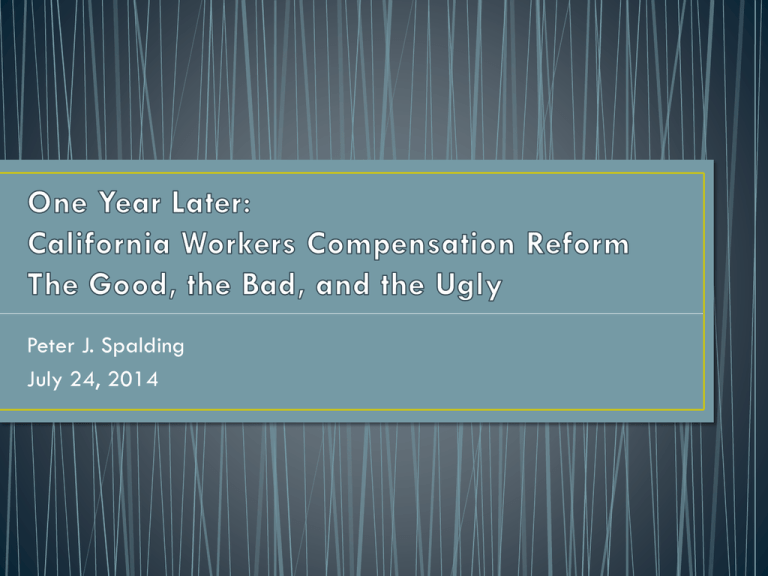
Peter J. Spalding July 24, 2014 • Every attempt has been made to provide you with accurate information. However, the laws are subject to different interpretations, and the details in many areas remain subject to change. The information presented is intended to be general in nature and should not be interpreted as legal advice. • The opinions and analyses presented in this session are those of the speaker alone. They do not necessarily reflect the views of the State of California or any of its agencies, nor that of Liberty Mutual Insurance. • Slides with white backgrounds are taken from the state’s own presentations but have been edited for brevity. The unedited state’s presentations are available on DWC’s website. • At the end of this presentation, you should be able to: • Identify the key changes to California Workers Compensation since 2013 • Understand how these changes impact patients and medical providers • Navigate (and help the patient navigate) in the new environment • Workers Comp is designed to be a compromise between employers and employees • America’s oldest form of health and disability insurance, created in response to the Industrial Revolution • Details vary from state to state, but the “grand bargain” was: • Employers were required to pay for work injuries, regardless of fault • In exchange, injured workers gave up the right to sue • Some public-policy exceptions for willful misconduct, intoxication, etc. • Goal was (and still is) to benefit both sides: • Injured workers are supposed to get prompt and effective treatment, and return to work as early as possible • Employers have a financial motivation to keep their workplaces safe, and they’re protected from costly lawsuits • Senate Bill 863 was negotiated by a task force of employers and labor groups • Its overarching goals were: • Increase benefits to injured workers (especially Permanent Disability) • Reduce costs to employers (especially litigation and other administrative costs) • Specific to medical treatment: • • • • Expedite treatment Make sure it’s as effective as possible Resolve disputes early Eliminate common areas for abuse • Treatment guidelines were already in place pre-S.B. 863 • ACOEM Guidelines were implemented in 2004 • MTUS (which is largely based on ACOEM) was implemented in 2009 • However, these guidelines were often difficult to enforce • When treatment was unlikely to help a patient, it could be hard to say no • Disputes typically went to either Agreed Medical Examiners (AME’s) or Qualified Medical Examiners (QME’s) who would make their own determinations that may or may not follow the guidelines • Claims administrators tried to “choose their battles” to avoid litigation • There was a small cottage industry that purposely ignored the guidelines • Attorneys would often send clients to providers who would “tell them what they wanted to hear” • Could be a lucrative business • S.B. 863 made these guidelines enforceable by requiring that disputes follow a more clearly-defined process • The new laws strive to: • Ensure injured workers get the best treatment possible, based on scientifically-proven evidence • Lay down clear ground rules to avoid confusion and back-and-forth • Get disputes resolved by medical professionals, not judges or attorneys • Resolve these issues faster than the old AME/QME process • The challenges now are: • It can be hard to apply the guidelines in the real world (i.e. exam room) • There’s also a learning curve, especially for people who may not have paid much attention to the guidelines before • Unfortunately, no guideline is perfect, and each patient is different • To start the process, providers submit Request for Authorization (RFA) to Utilization Review (UR) • If a request is clearly appropriate, UR approves it outright • Legally, anyone can approve a request (although company policies vary) • UR companies typically send these requests to nurses • If a request is questionable, it is “elevated” to peer review • Only licensed physicians can delay, deny, or modify a treatment request • UR companies typically send these requests to outside peer reviewers • If a patient disputes the decision, there is an appeals process • Regulations require them to make the request within 10 days • Often resolves disputes outright, without needing IMR Source: Division of Workers Compensation, January 2014 Source: DWC, Jan. 2014 • Decisions are supposed to be final, unless appealed through IMR • Decisions remain valid for 12 months Source: DWC, Jan. 2014 • Independent Medical Review (IMR) is now supposed to be the only way to resolve disputes of medical necessity • It does not resolve other types of medical disputes such as: • Whether an injury is work-related • Whether a patient is required to treat within an MPN • Whether a patient is disabled and/or reached MMI • If there is an underlying dispute, it must be resolved first before IMR can apply • Patient has 30 days from the UR decision to request IMR • Essentially, the patient is appealing the decision to the state • Maximus Federal Services is currently handling IMR on behalf of the state; they’re the exclusive provider through 12/31/14 • Pre-populated request form is included with all UR denial notices, along with an envelope, so the patient only needs to sign it & mail it Source: DWC, Jan. 2014 Source: DWC, Jan. 2014 Source: DWC, Jan. 2014 Source: DWC, Jan. 2014 Source: DWC, Jan. 2014 • Overwhelmed the system in fall 2013 • State now says they have worked through the backlog Source: DWC, Jan. 2014 Source: DWC, Jan. 2014 Source: DWC, Jan. 2014 • Make sure you’re familiar with the guidelines: • MTUS states the goal of treatment is to optimize functional recovery, including work-related and non-work related quality of life • The bulk of MTUS is taken verbatim from ACOEM, but it does include special sections for chronic pain, post-surgical treatment, and acupuncture • If a particular treatment or injury is not addressed by MTUS, the following are to be used as backups (in this order): • Peer-reviewed scientific and medical evidence regarding the effectiveness of the disputed service • Nationally recognized professional standards • Expert opinion • Generally accepted standards of medical practice • Treatments that are likely to provide a benefit to a patient for conditions for which other treatments are not clinically efficacious • Make sure you’re familiar with the guidelines (cont.) • There is a 24-visit cap for physical therapy, occupational therapy, and chiropractic care • Patient can get up to 24 visits of each • Treatment is still subject to MTUS before the 24 visits are reached • Once the patient does reach 24 visits, the only exceptions are: • If the patient is post-op • If the injury is pre-1/1/04 • Employers can authorize additional visits but they’re not required to • Home health care must meet specific criteria • Must be prescribed by a licensed physician/surgeon • There are limits on retroactive requests (i.e., family members saying they’ve been providing services for years) • Recently clarified in the case law in “Hernandez” • Certain treatments may require careful handling • Opioid usage is always a hot-button issue (especially on chronic cases) • MTUS typically does not favor: • Special diagnostics or surgeries within the first few weeks post-injury, unless there are red flags such as fracture, cauda equina, etc. • Compound medications • Experimental treatments • MTUS may not specifically address: • Treatments that are no longer experimental but not yet commonly used • Injuries or specialties that are unusual in Workers Comp (such as dental, ophthalmology, etc.) • If a treatment plan involves any of these, be prepared to explain the rationale to the peer reviewer • Patients sending incomplete IMR requests • Most common problem was a missing copy of the UR denial • Initially, Maximus was asking patients to send in additional info; now Maximus is rejecting those requests outright • Request form has been revised to minimize the risk of missing info • Attorneys attacking the IMR process • IMR is supposed to be binding, with very few grounds for appeal • Attorneys are trying to find loopholes • Typically argue that the UR decision is invalid due to a technicality • This practice is especially prevalent in Northern CA • The only case law to date is “Dubon” which is up on appeal • The court found that if a UR decision is invalid, then IMR doesn’t apply • Minor technicalities don’t invalidate a decision, but “material defects” do Source: DWC, Jan. 2014 • All networks must have “Medical Access Assistants” • Their role is to help injured workers find physicians, contact providers, and schedule appointments when necessary • Available via toll-free number from 7 a.m. to 8 p.m., Mon.-Sat. • Must be located within the United States (i.e., no overseas call centers) • For example, Liberty Mutual’s protocols are: • Toll-free number is the same for all patients: (800) 944-0443 • This number automatically appears on the online network listings • All MPN patients receive notices explaining the details • • • • Networks must post their listings online & update them quarterly Networks are required to have a quality review process All providers must acknowledge their network status in writing If networks fail to comply, they’re subject to penalties • If there is a dispute over whether a patient must treat in an MPN: • Matter is to go to an expedited hearing • No other issues may be heard till it’s resolved • Goal is to resolve these disputes early & move on • Failure to provide notice is not sufficient to allow treatment outside the MPN, unless it “resulted in a denial of medical care” • Arguably this has been the law all along, under “Knight” • Goal is to avoid unnecessary litigation over technicalities, and instead focus on whether the patient is getting the right treatment • Reports from unauthorized providers can’t be the sole basis for an award; instead, the AME/QME or PTP must determine whether they agree • Other behind-the-scenes changes: • Any employee with group health coverage can pre-designate a provider (before, they could only do it if the coverage was through the employer) • Updates to the approval process • Regulators have always been required to approve a network before it can go into effect, but the specifics have been revised • If anyone disputes regulators’ approval of an MPN, they have to take it up with the state; local WC judges have no jurisdiction over it • 25% non-occupational requirement has been removed • Some MPN’s don’t cover the entire state • Most statewide employers & claims administrators do cover the whole state • Smaller employers may use a smaller MPN that only covers their area • Providers may be scarce in some areas • Rural parts of the state • Specialties that are unusual in WC • If no in-network provider is available, the claims administrator must authorize treatment out-of-network • Out-of-state treatment is always a challenge • Providers may be reluctant to deal with another state’s protocols • MPN’s are unique to California, but some states do have similar networks (such as Texas HCN’s) • Official Medical Fee Schedule (OMFS) is being overhauled • Changes are being phased in over four years beginning 1/1/14 • Incorporating Medicare Resource-Based Relative Value Scale (RBRVS) to bring CA more in line with other states • The most notable changes are: • Higher reimbursement rates for PTP’s/ general practitioners • Lower reimbursement rates for specialists (esp. surgery centers) • Removed codes that some providers had been using for meetings with Nurse Case Managers • Resulted in some providers not wanting to meet with NCM’s • Providers can still bill for this, but they need to use other codes • New fee schedules are being drafted in certain areas: • For medical providers, the main impact is in home health care • Other fee schedules are non-medical (such as interpreters) • Billing disputes go through a process similar to IMR • Applies to all dates of service on or after 1/1/13 • Providers are not allowed to file liens for disputes subject to IBR • IBR is the only way to resolve disputes over the fee schedule, and WC judges have no authority to override it • Volume is much lower than anticipated • Maximus has received ~ 1,700 IBR requests since the laws took effect • Compare this to > 100,000 IMR requests • State recently reduced the IBR fees • Providers must pay a fee upfront to request IBR; however, if IBR finds money is owed, the provider gets reimbursed by the claims administrator • Originally $335 per request • Reduced to $250 per request, effective 4/1/14 • State is refunding providers who paid the higher fee post-4/1/14 • Clock starts ticking after claims administrator makes its decision on appeal • Applications can be submitted by mail, fax, or online Source: Division of Workers Compensation, May 2014 Source: DWC, May 2014 Source: DWC, May 2014 Source: DWC, May 2014 • Medical-legal bills are subject to their own dispute resolution process under Labor Code 4622(c): • Medical-legal fee schedule disputes are subject to IBR • If a bill is denied outright, the provider has 90 days to object to denial • If no objection is made, the denial becomes final • If an objection is made, the employer is required to file for hearing • Few if any providers have followed this process to date • Significant limits on liens • It’s the lien claimant’s responsibility to prove a bill is owed • In most cases, payment must go to the original provider, not a collector • All medical liens filed on or after 1/1/13 are subject to a fee of $150 • If the fee is not paid, the filing does not count • Reimbursable in certain situations under Labor Code 4903.07 • (Filings pre-1/1/13 are also supposed to be subject to a fee, but those fees have been put “on hold” while the issue is being litigated) • Filings must be done within a new Statute of Limitations: • For dates of service prior to 7/1/13: 3 years from DOS • For dates of service on or after 7/1/13: 18 months from DOS • Only exception is for group health liens that meet specific criteria; those must be filed within 1 year of knowledge of the WC injury • Controversy over the changes in the fee schedule • Difficulty in changing behavior • Claims administrators do need to pay what is owed; reforms are not an excuse to deny bills inappropriately • Certain providers are still pursuing frivolous liens • Can overshadow the legitimate disputes that are out there • In the long run, this increases costs for everyone concerned • Uncertainty over the “activation fees” • These fees are supposed to apply to liens filed pre-1/1/13 • Lawsuit claims the fees are unconstitutional (called “Angelotti”) • Most portions of the case have been dismissed but are up on appeal • No end in sight as of yet • All other lawsuits on this issue have been dismissed • Know and understand the treatment guidelines • Focus on functional improvement and return-to-work • Keep open lines of communication between all parties: • • • • • Patient Treating physician Employer Adjuster UR reviewer • Always resolve disputes as early as possible! • Don’t let problems fester, because that makes them worse • Many disputes must be raised within a strict legal deadline • If you are the treating provider: • Always seek authorization first, unless it’s a medical emergency or some other extenuating circumstance • Submit complete RFA’s for all treatment requests • Make sure you can justify all requests based on the guidelines • You generally shouldn’t need to cite specific guidelines on RFA’s • However, be prepared to provide guidelines if asked by UR • Avoid filing liens unless absolutely necessary • In most cases, there are better ways to resolve disputes; remember that all other states manage to get by without liens at all! • Be careful about using third-party collectors • You can still retain a collection agency to act as your representative • However, in most cases you can no longer sell off your accounts • WCAB website: http://www.dir.ca.gov/wcab/ • Includes a lot of legal information, but not much for providers per se • Key pieces of case law (called en banc decisions) are posted on this site • DWC website: http://www.dir.ca.gov/dwc/ • Lots of good information, once you learn how to navigate it • Typically the best resources for injured workers are: • Information and Assistance (I&A) Unit • Many educational documents available online • Each DWC/WCAB office holds monthly training sessions for the public • DWC website: http://www.dir.ca.gov/dwc/ Pages dedicated to: • Injured workers • Medical providers Section on S.B. 863 • Frequently asked questions • Rulemaking & public comments • DWC website: http://www.dir.ca.gov/dwc/ MPN section includes a list of all approved networks MTUS section explains treatment guidelines in detail • Complete text of S.B. 863: • http://www.leginfo.ca.gov/pub/11-12/bill/sen/sb_08510900/sb_863_bill_20120919_chaptered.html • Also posted on the DWC website • Complete text of California statutes: • http://leginfo.legislature.ca.gov/faces/codes.xhtml • Most WC laws are in Labor Code sections 3200-6002 • Complete text of California regulations: • http://www.calregs.com/ • Most WC regulations are in Title 8 • Chapter 1 covers QME regulations (eligibility, testing, etc.) • Chapter 4.5 covers most other WC issues (MPN’s, court rules, etc.)

